|
Earhart Project Research Bulletin #31
April 5, 2001 |
| A Shoe Fetish, Part 2 |
Among
the most interesting artifacts found by TIGHAR on Nikumaroro are the
remains of a shoe which appears to have been similar in many respects
to the shoes Earhart was wearing when she disappeared—but is it Amelia’s
shoe? Here is Part Two of a detailed review of what was found and what
it may mean.
|
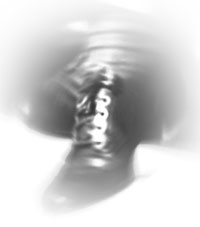 In assessing
whether the shoe artifacts found on Nikumaroro (see Shoe
Fetish Part 1) might be related to the Earhart disappearance we need
to answer two questions: In assessing
whether the shoe artifacts found on Nikumaroro (see Shoe
Fetish Part 1) might be related to the Earhart disappearance we need
to answer two questions:
- What
information is available about the style and size of shoes that were
aboard NR16020 when it vanished?
- How do
those shoes compare with the artifacts found on the island?
|
Earhart’s Shoes on the
Second World Flight Attempt |
| In
an article appearing in the New York Herald Tribune on Sunday, March
7, 1937--ten days before she would depart on the first World Flight attempt--the
footgear she planned to take on the trip was described this way: |
| |
In the
plane she’ll wear light, low shoes. And this time she’s taking along a pair
of heavy, high hiking boots “just in case,”as she puts it. |
| A
passage in Last Flight, in the chapter entitled “Fortaleza and Natal,”
describes what she took along on the second World Flight attempt: |
| |
My wardrobe
included five shirts, two pairs of slacks, a change of shoes, a light working
cover-all and a trick weightless raincoat, plus the minimum of toilet articles. |
| The
implication is that she had two pair of shoes with her, but photographs
seem to indicate that there were actually three pair. |
  The
photo at left was taken on June 17, 1937 upon AE's arrival in Calcutta, India.
Her shoes are blucher-style oxfords (see Shoe
Fetish Part 1 for definitions of shoe styles) featuring metal shoelace
eyelets. Other photos taken during preparation for the World Flight
in March 1937 show her wearing what appear to be the same shoes. We’ll
call these Pair No. 1. The
photo at left was taken on June 17, 1937 upon AE's arrival in Calcutta, India.
Her shoes are blucher-style oxfords (see Shoe
Fetish Part 1 for definitions of shoe styles) featuring metal shoelace
eyelets. Other photos taken during preparation for the World Flight
in March 1937 show her wearing what appear to be the same shoes. We’ll
call these Pair No. 1.
Photos courtesy Purdue collection.
 The photo
at right was taken in Bandoeng, Java sometime between June 21 and 27, 1937.
AE’s shoes, although very similar to the ones in the Calcutta photo above,
have a toe cap that is absent in the other blucher oxfords. These toe-capped
shoes also appear in photos taken the previous March. We’ll call these Pair
No. 2. The photo
at right was taken in Bandoeng, Java sometime between June 21 and 27, 1937.
AE’s shoes, although very similar to the ones in the Calcutta photo above,
have a toe cap that is absent in the other blucher oxfords. These toe-capped
shoes also appear in photos taken the previous March. We’ll call these Pair
No. 2.
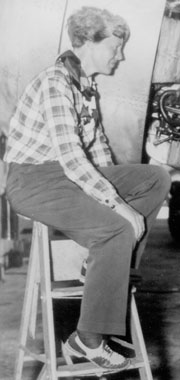 This
photo shows AE possibly in Miami in late May 1937. The distinctive shoes
she is wearing appear in several photos taken during the World Flight, always
in a sight-seeing or non-flying context. They seem to have been her walking-around
shoes. The sole and heel are both light colored. We’ll call these Pair No.
3. This
photo shows AE possibly in Miami in late May 1937. The distinctive shoes
she is wearing appear in several photos taken during the World Flight, always
in a sight-seeing or non-flying context. They seem to have been her walking-around
shoes. The sole and heel are both light colored. We’ll call these Pair No.
3.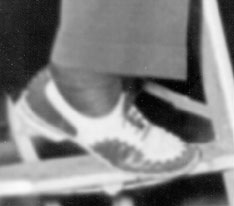
|
| How
do Earhart’s Shoes Compare With
the Artifacts Found on the Island? |
| |
There
seem to be four criteria we can use to determine similarities and differences
between the shoes Earhart is known to have worn and the remnants of shoes
TIGHAR found on Nikumaroro: style, gender, special features, and size. |
Style
|
| |
Pairs
1 & 2 were blucher style oxfords. Pair 3 were oxfords but not blucher
style. All we can say about the style of the shoe whose sole and heel were
found on the island is that it had leather uppers stitched to a rubber sole.
If the brass eyelet (Artifact 2-2-G-7/6) found with the sole and heel is
a shoelace eyelet, then it seems safe to conclude that the shoe was an oxford
(i.e. lace-up) style. From a style standpoint alone, the shoe found by TIGHAR
could be any, or none, of Earhart’s three known pair. |
Gender
|
| |
Of
Earhart’s known shoes, pairs 1 & 2 seem to be distinctly female, pair
3 less so. The experts at Biltrite felt that the "fine and close"
stitching holes in the sole found on the island are indicative of a woman’s
shoe and that the small size of the brass eyelet further suggests that the
shoe was female. If they’re correct, then the shoe found on the island was
a woman’s oxford. Earhart wore women’s oxfords. |
Special
Features
|
| |
The
shoe found on the island had three distinctive features:
- brass shoelace eyelets (if the single eyelet found is a shoelace eyelet)
- a black rubber sole (assuming the color has not changed over time)
- a Cat’s Paw replacement heel that originally featured two white traction plugs.
|
| |
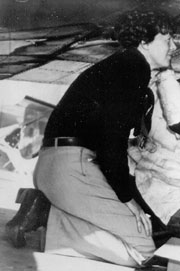 These
features would seem to eliminate Earhart’s pair 3 which did not have metal
eyelets and featured a light colored sole and heel. Pairs 1 & 2 did
feature metal eyelets and dark soles. Were the soles rubber? It’s hard to
be sure, but the photo at right and below, (taken in late February 1937
during preparation for the first World Flight attempt), provides a rare
glimpse at the bottom of AE’s blucher oxfords (although it’s not clear whether
this is pair 1 or pair 2). These
features would seem to eliminate Earhart’s pair 3 which did not have metal
eyelets and featured a light colored sole and heel. Pairs 1 & 2 did
feature metal eyelets and dark soles. Were the soles rubber? It’s hard to
be sure, but the photo at right and below, (taken in late February 1937
during preparation for the first World Flight attempt), provides a rare
glimpse at the bottom of AE’s blucher oxfords (although it’s not clear whether
this is pair 1 or pair 2).
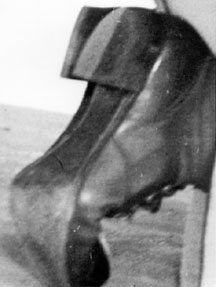 The uniformly black sole seems to be more consistent with rubber than with
leather. Note also the lines of stitching along the edges. The uniformly black sole seems to be more consistent with rubber than with
leather. Note also the lines of stitching along the edges.
The heels of the shoes in this photo appear uniformly black and perhaps
a bit worn. No white traction plugs are evident. Contrast that
with the photo below, taken a few days later in early March 1937.
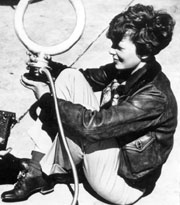 This
is Pair 2 (note the toe cap) and the lighter-colored bottom of the heel looks
markedly different from the heel in the earlier photo. This
is Pair 2 (note the toe cap) and the lighter-colored bottom of the heel looks
markedly different from the heel in the earlier photo.
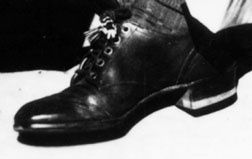
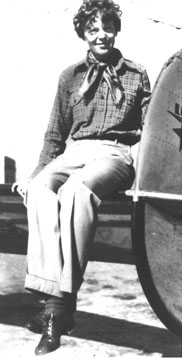 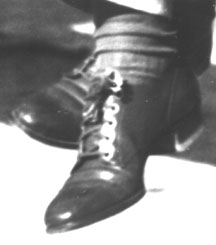 This
is pair 1 around the same time. They have the same look to the heel. It would
appear that Earhart had the heels of both pair of blucher oxfords replaced
as part of her World Flight preparations. This
is pair 1 around the same time. They have the same look to the heel. It would
appear that Earhart had the heels of both pair of blucher oxfords replaced
as part of her World Flight preparations.
The reconstructed sole measures roughly 277mm or 10.9 inches, equivalent
to an American woman’s size 8 1/2 or 9. What size were the shoes AE had with
her on the world flight? The available evidence is, to say the least, contradictory
and falls into four general categories: anecdotal, analytical, artifactual,
and photogrammetric. |
Anecdotal
|
| |
During
the 1970s, in the context of allegations that New Jersey housewife Irene
Bolam was, in fact, Amelia Earhart, AE’s sister, Muriel Morrissey, maintained
that Amelia had very small feet. Conversely, former U.S. Customs inspector
Peggy Sledge, in her book The Littlest Smuggler and Other True Stories tells of frequent visits by Earhart and the standing jokes about her big
feet. |
Analytical
|
| |
Earhart’s
height, according to the information on her pilot’s license, was 5 feet
8 inches. U.S. Army data for predicting foot size by height (useful in knowing
what size shoes to stock) indicates that the average foot size for an American
woman 5 feet 8 inches tall is 257mm ± 9.03mm. In other words, if Earhart
had “normal” size feet for her height they were between 248mm
and 266mm in length. Her shoes, of course, would be somewhat longer. |
Artifactual |
| |
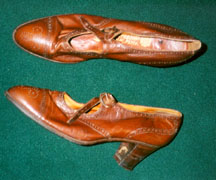 We’re
aware of two existing pairs of shoes that once belonged to Earhart. The
Atchison County Historical Society Museum in Atchison, Kansas (Earhart’s
birthplace) has a pair of brocade dancing slippers that are reportedly size
6 1/2. It’s not clear when in her life Amelia wore them. We’re
aware of two existing pairs of shoes that once belonged to Earhart. The
Atchison County Historical Society Museum in Atchison, Kansas (Earhart’s
birthplace) has a pair of brocade dancing slippers that are reportedly size
6 1/2. It’s not clear when in her life Amelia wore them.
TIGHAR
has a pair of dress shoes (shown at right) that Amelia reportedly purchased
in Ireland in 1932. She gave them to her friend Helen Hutson Weber in November
of that year, according to Ms. Weber, “not for sentimental reasons but because
they hurt her.” The shoes measure 254mm or 10 inches in length, roughly
an American woman’s size 6 1/2. The shoes are quite narrow, AA or perhaps even
AAA width. |
Photogrammetric |
| |
 This
photograph shows Earhart standing on the wing of NR16020 in Bandoeng, Java
approximately ten days before her disappearance. She is wearing pair 2 and
we have a good profile view of her right foot. The rivet lines on the wing
are 65mm or 2.5 inches apart, thus providing a convenient scale for measuring
the shoe. A straightforward measurement of the shoe in the photo suggests
a length of about 278 mm, virtually identical to the length of the reassembled
sole found on the island. This
photograph shows Earhart standing on the wing of NR16020 in Bandoeng, Java
approximately ten days before her disappearance. She is wearing pair 2 and
we have a good profile view of her right foot. The rivet lines on the wing
are 65mm or 2.5 inches apart, thus providing a convenient scale for measuring
the shoe. A straightforward measurement of the shoe in the photo suggests
a length of about 278 mm, virtually identical to the length of the reassembled
sole found on the island.
However, a recent forensic imaging analysis of the photo
by Photek, Inc. of Portland , Oregon tells a different story. As described
fully in his Preliminary Letter
Of Opinion Jeff Glickman of Photek measured the sole of the shoe in
the photo at 242.9mm or 9.6 inches – roughly an American woman’s size
6. The same forensic techniques showed the heel of the shoe in the photo
to be 55.1mm or 2.16 inches in length. Obviously, comparisons of the length
of the sole of Earhart’s shoe to the fragmented sole found on the island
are imprecise because we can’t know whether we've reassembled the island
sole accurately, but the heel comparisons should be fairly reliable.
Photek
also performed a forensic imaging
analysis on the heel. At 2.16 inches, the heel in the photo seems
to be significantly smaller than the 3 inch long heel found on the island.
IF the island heel has not swollen significantly due to environmental
conditions (such swelling seems very unlikely), and IF Glickman's measurement
of the heel in the photo is correct THEN they can not be the same heel.
But here’s the problem: if the photogrammetric measurements are correct,
how could a 254mm dress shoe that hurt Earhart’s feet be over a centimeter
larger than a 243mm “working” shoe she wore with socks? |
|
Clearly,
we haven’t yet solved the riddle of Amelia’s shoes. |
But
What About Fred’s Shoes?
|
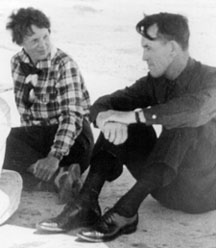 In this
photo, probably taken in Miami in late May, 1937, Fred Noonan is wearing
the type of shoes he’s wearing in virtually all of the available photos.
Indeed, Fred’s entire wardrobe seems to consist of the same dark shirt
and dark tie with little white polka dots, dark trousers, dark socks and
dark oxfords. In this
photo, probably taken in Miami in late May, 1937, Fred Noonan is wearing
the type of shoes he’s wearing in virtually all of the available photos.
Indeed, Fred’s entire wardrobe seems to consist of the same dark shirt
and dark tie with little white polka dots, dark trousers, dark socks and
dark oxfords.
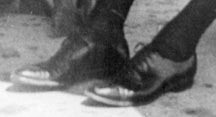 We don’t
have any hard information about Fred’s shoe size but we do know that his
height was six feet one-quarter inch, and his feet appear to be in prportion
to his body. A fair guess might be that he wore something between an American
man's size 11 (320mm) and size 13 (340mm) – much too large to be the
sole found on the island but perhaps not inconsistent with the second
shoe heel (Artifact 2-2-G-9). We don’t
have any hard information about Fred’s shoe size but we do know that his
height was six feet one-quarter inch, and his feet appear to be in prportion
to his body. A fair guess might be that he wore something between an American
man's size 11 (320mm) and size 13 (340mm) – much too large to be the
sole found on the island but perhaps not inconsistent with the second
shoe heel (Artifact 2-2-G-9).
|
Conclusions |
Sometimes
it seems like the more we know, the less we know. The only conclusion
we can draw at this point is that we need more information before we can
make any reliable determination whether the shoe parts found in 1991 might
reasonably be associated with the Earhart disappearance. We need to re-examine
the assumptions from which we’ve derived data that seem to be contradictory.
For example, our measurement of the rivet spacing on the Electra wing
was obtained from one Lockheed 10. All Lockheed 10s should have the same
spacing, but is that a valid assumption? Are there more shoes once owned
by Amelia Earhart kicking around someplace that we could measure? We’re
already trying to pin down a more precise date for the Cat’s Paw heel.
If it turns out that that particular design post-dates the disappearance
by even a few weeks we’ll know that the island shoe cannot be Earhart’s.
As always,
we welcome your input and will try to keep you up to date as we continue
to piece together this puzzle.
|


 In assessing
whether the shoe artifacts found on Nikumaroro (see
In assessing
whether the shoe artifacts found on Nikumaroro (see 
 The
photo at left was taken on June 17, 1937 upon AE's arrival in Calcutta, India.
Her shoes are blucher-style oxfords (see
The
photo at left was taken on June 17, 1937 upon AE's arrival in Calcutta, India.
Her shoes are blucher-style oxfords (see  The photo
at right was taken in Bandoeng, Java sometime between June 21 and 27, 1937.
AE’s shoes, although very similar to the ones in the Calcutta photo above,
have a toe cap that is absent in the other blucher oxfords. These toe-capped
shoes also appear in photos taken the previous March. We’ll call these Pair
No. 2.
The photo
at right was taken in Bandoeng, Java sometime between June 21 and 27, 1937.
AE’s shoes, although very similar to the ones in the Calcutta photo above,
have a toe cap that is absent in the other blucher oxfords. These toe-capped
shoes also appear in photos taken the previous March. We’ll call these Pair
No. 2.
 This
photo shows AE possibly in Miami in late May 1937. The distinctive shoes
she is wearing appear in several photos taken during the World Flight, always
in a sight-seeing or non-flying context. They seem to have been her walking-around
shoes. The sole and heel are both light colored. We’ll call these Pair No.
3.
This
photo shows AE possibly in Miami in late May 1937. The distinctive shoes
she is wearing appear in several photos taken during the World Flight, always
in a sight-seeing or non-flying context. They seem to have been her walking-around
shoes. The sole and heel are both light colored. We’ll call these Pair No.
3.
 These
features would seem to eliminate Earhart’s pair 3 which did not have metal
eyelets and featured a light colored sole and heel. Pairs 1 & 2 did
feature metal eyelets and dark soles. Were the soles rubber? It’s hard to
be sure, but the photo at right and below, (taken in late February 1937
during preparation for the first World Flight attempt), provides a rare
glimpse at the bottom of AE’s blucher oxfords (although it’s not clear whether
this is pair 1 or pair 2).
These
features would seem to eliminate Earhart’s pair 3 which did not have metal
eyelets and featured a light colored sole and heel. Pairs 1 & 2 did
feature metal eyelets and dark soles. Were the soles rubber? It’s hard to
be sure, but the photo at right and below, (taken in late February 1937
during preparation for the first World Flight attempt), provides a rare
glimpse at the bottom of AE’s blucher oxfords (although it’s not clear whether
this is pair 1 or pair 2).  The uniformly black sole seems to be more consistent with rubber than with
leather. Note also the lines of stitching along the edges.
The uniformly black sole seems to be more consistent with rubber than with
leather. Note also the lines of stitching along the edges. This
is Pair 2 (note the toe cap) and the lighter-colored bottom of the heel looks
markedly different from the heel in the earlier photo.
This
is Pair 2 (note the toe cap) and the lighter-colored bottom of the heel looks
markedly different from the heel in the earlier photo.

 This
is pair 1 around the same time. They have the same look to the heel. It would
appear that Earhart had the heels of both pair of blucher oxfords replaced
as part of her World Flight preparations.
This
is pair 1 around the same time. They have the same look to the heel. It would
appear that Earhart had the heels of both pair of blucher oxfords replaced
as part of her World Flight preparations. We’re
aware of two existing pairs of shoes that once belonged to Earhart. The
Atchison County Historical Society Museum in Atchison, Kansas (Earhart’s
birthplace) has a pair of brocade dancing slippers that are reportedly size
6 1/2. It’s not clear when in her life Amelia wore them.
We’re
aware of two existing pairs of shoes that once belonged to Earhart. The
Atchison County Historical Society Museum in Atchison, Kansas (Earhart’s
birthplace) has a pair of brocade dancing slippers that are reportedly size
6 1/2. It’s not clear when in her life Amelia wore them. In this
photo, probably taken in Miami in late May, 1937, Fred Noonan is wearing
the type of shoes he’s wearing in virtually all of the available photos.
Indeed, Fred’s entire wardrobe seems to consist of the same dark shirt
and dark tie with little white polka dots, dark trousers, dark socks and
dark oxfords.
In this
photo, probably taken in Miami in late May, 1937, Fred Noonan is wearing
the type of shoes he’s wearing in virtually all of the available photos.
Indeed, Fred’s entire wardrobe seems to consist of the same dark shirt
and dark tie with little white polka dots, dark trousers, dark socks and
dark oxfords. We don’t
have any hard information about Fred’s shoe size but we do know that his
height was six feet one-quarter inch, and his feet appear to be in prportion
to his body. A fair guess might be that he wore something between an American
man's size 11 (320mm) and size 13 (340mm) – much too large to be the
sole found on the island but perhaps not inconsistent with the second
shoe heel (Artifact 2-2-G-9).
We don’t
have any hard information about Fred’s shoe size but we do know that his
height was six feet one-quarter inch, and his feet appear to be in prportion
to his body. A fair guess might be that he wore something between an American
man's size 11 (320mm) and size 13 (340mm) – much too large to be the
sole found on the island but perhaps not inconsistent with the second
shoe heel (Artifact 2-2-G-9).